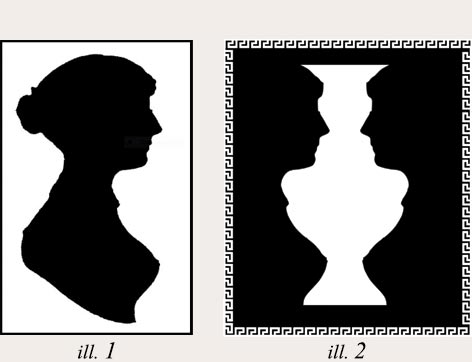Cover Storye™
Why the ‘face or vase illusion’...
Cover art by Leslie Bell,
depicting The Amiable Cassandra’s heroine, Cassandra Ashton-Dennis,
in ‘face or vase illusion’, otherwise known as ‘Rubin’s vase’. Commissioned by Hye St. Press.

The inspiration for the cover picture above is modeled upon the original silhouette hereunder in ill. 1 of (it is presumed) Jane Austen, c. 1810-1815 (the silhouette has been attributed to a silhouette-maker, Mrs. Collins, who worked in Bath around 1800. [Public domain], via Wikimedia Commons) and then as subsequently depicted in its Rubin’s vase version in ill.2 (JaneAustenSilhouette.png: Mrs. Collins derivative work: Leslie Bell).
As indicated, the original silhouette portrait (ill.1) of Jane Austen by Mrs. Collins was discovered pasted in a second-edition copy of Mansfield Park in 1944. On the silhouette was inscribed ‘'L'aimable Jane’. “Who,” writes renowned Austen authority and critic, R. W. Chapman, “would insert in a copy of Mansfield Park, a portrait of any other Jane than its author?”
The optical illusion of Rubin’s vase, as per ill.2 of the Collins-silhouette, allows the viewer to make two valid interpretations of the image. One obstructs the other, however, preventing the viewer from comprehending both interpretations simultaneously. This ‘appearance versus reality’ theme is both central to the plot of The Amiable Cassandra and indeed the entire conceit inspiring The Bath Novels of Lady A~.
Just as the author’s name, ‘Lady A~’, is a pseudonym taken from the actual pseudonym given to Jane Austen by the beau monde of the day*, the Rubin’s vase cover-depiction of The Amiable Cassandra’s heroine, Cassandra Ashton-Dennis, similarly reflects a duality of identity both in ‘author attribution’ and persona. In this second Bath Novel, Jane Austen has seemingly transposed herself and her connections into a novel that becomes a story of its own, and one that incorporates the parallel enigmatic ‘history’ of the Bath Novels. Hence the book’s title aptly echoing the actual inscription of the Collins-silhouette of Jane Austen: ‘'L'aimable Jane’. The cover picture further reflects the notion in The Amiable Cassandra that ‘Jane Austen, a.k.a. Lady A—’, created its heroine to ‘mirror’ herself in every respect but independently from her—thus living and working in a parallel but wholly altered microcosm. Thus, like the Rubin’s vase, two halves making up two entirely different ‘wholes’, and owing solely to perspective.
It also suggests why the name ‘Cassandra Ashton-Dennis’ is therefore a moniker-charade. Jane Austen’s sister, Cassandra, was her greatest ally and confidante and the two were inseparable, just like the illusive interpretation of a Rubin’s vase in art. If there was one, there was the other one. Two separate entities that each formed/reflected a part of the other-life’s picture. Hence the choice of the heroine’s name, ‘Cassandra’, for the character of ‘Jane’ in The Amiable Cassandra.
Furthermore, the surname ‘Ashton-Dennis’ was a pseudonym Austen used to liaise with an erstwhile publisher, Richard Crosby. This suggests a further appellative ‘clue’ that this particular Bath Novel is really a fictional biography, inspired in part by the events and characters that filled Austen’s eventful short history. It surely must have been the novel Austen was supposedly dictating to its conclusion to (significantly) her sister Cassandra, as her own untimely end approached in Winchester in 1817 (See: Preface to The Bath Novels of Lady A~).
Lastly, Jane Austen’s early writings or ‘juvenilia’ include a novella entitled The Beautifull Cassandra [sic], a composition dedicated to her sister, Cassandra, whom she denotes as ‘Miss Austen’. It is essentially a parody—a humorous, exaggerated imitation of the type of sentimental stories that were popular at the time. The Amiable Cassandra’s title therefore does not just purposely echo The Beautifull Cassandra, as a nod to her ‘complementing’ sister and early parody, but it also gives readers a hint that it could be a retelling or ‘imitation’ of a popular, ‘familiar’ story (from a peculiar point of view); namely that of Jane Austen’s life. In so doing it further highlights the symbolic mutable ‘nature’ of the cover picture and its relevance to assumed identities regarding ‘authorship’ and characterization throughout The Amiable Cassandra. Thus the fanciful notion of Jane Austen transforming into the ‘shade’ of a fictional ‘Cassandra’ alongside altered delineations of her known history, and those of her connections, becomes all the more tantalizing. But most especially because it is penned by a lady known only to her readers as ‘Lady A—’, which, as previously stated, was the fashionable pseudonym once popularly applied to Jane Austen…

* The Regency’s beau monde changed Jane Austen’s chosen pseudonym ‘A Lady’ to ‘Lady A—’... 


